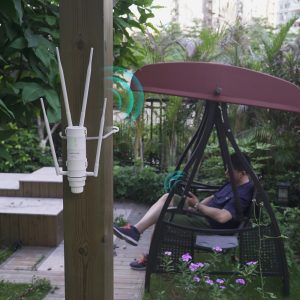When setting up a network that extends to outdoor spaces, selecting the right wifi range extender outdoor model is crucial to ensuring reliable and strong internet connectivity. This guide will navigate you through key features and specifications to consider, ensuring that you make an informed choice tailored to your specific needs.
High Power Output
For outdoor environments, power output significantly impacts the effectiveness of a WiFi range extender. Look for devices with a higher power output, usually measured in milliwatts (mW). Extenders that offer between 500 mW to 1000 mW can push signals farther and are more capable of penetrating physical barriers commonly found outdoors, such as walls and foliage.
Robust Antenna Design
Antenna strength and design are paramount in broadcasting a strong WiFi signal across extensive outdoor areas. Extenders equipped with high-gain antennas (typically rated between 5 dB and 15 dB) enhance signal strength and quality. Decide between omnidirectional antennas for 360-degree coverage, ideal for covering large, open areas, or directional antennas that focus the signal in a specific direction, useful for targeting connectivity to remote locations.
Weather-Resistant Construction
Since the device will be exposed to the elements, it's essential to choose a WiFi extender that is built to withstand outdoor conditions. Look for extenders housed in weather-resistant enclosures that protect against moisture, dust, and extreme temperatures. These features ensure the extender operates effectively no matter the weather conditions, prolonging the device’s lifespan and ensuring consistent performance.
Dual-Band Functionality
A dual-band WiFi range extender can operate on both the 2.4 GHz and 5 GHz bands. The 2.4 GHz band offers better range through better penetration of solid objects, which is beneficial in cluttered outdoor settings. On the other hand, the 5 GHz band provides faster data speeds and is less prone to interference. Having both options available allows for more flexible and optimal outdoor network setup.

Ease of Installation and Management
For maximum efficiency, choose an extender that is easy to install and manage. Many modern extenders come with user-friendly interfaces and can be configured via a mobile app. Look for features like LED signal indicators which help in finding the best installation location to optimize signal strength and coverage.
Security Features
Security should never be compromised, especially in an outdoor setting where the hardware is more accessible. Ensure the extender supports the latest WiFi security protocols such as WPA2 or WPA3 to protect your network against unauthorized access.
Scalability and Interoperability
Consider whether the WiFi extender can integrate seamlessly with your existing network setup. It should be compatible with your current router and other network equipment. Additionally, check if the extender supports mesh networking, which allows multiple extenders to work together to form a larger, cohesive network without signal degradation.
Maximize Your Outdoor Connectivity
For those seeking to enhance their outdoor internet coverage effectively, a wifi range extender outdoor needs to be powerful, durable, and versatile. Investing in the right model not only extends your WiFi coverage but also ensures a reliable and secure connection that can significantly improve your outdoor living or working space. Choose wisely to stay connected in every corner of your outdoor environment.
